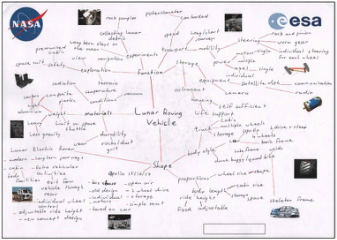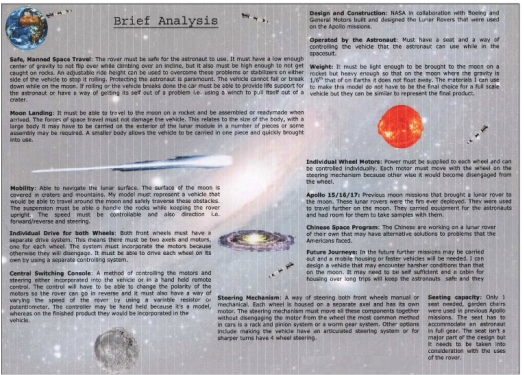Analysis of Brief |
|
Having read the brief a number of times the next stage is to gain a full understanding of what you are
being asked to do. At this stage it is very important that the brief is thoroughly analysed as it serves to inform you of the requirements and constraints of the brief. Performing a poor analysis may lead to overlooking a crucial requisite and hence producing an artefact which doesn’t completely satisfy the brief. Having performed a good analysis of the brief you should have clarity on what the brief sets out to achieve and have a clear route towards further investigation. Explore the brief carefully. Remember:
|

Steps in analysing the brief:
research paths.
brainstorming session.
Investigation of possible solutions:
Analysis of the design brief must be completed in order to progress to this stage. When the brief has
been fully analysed, a clear understanding of the requirements of the brief and a number of design
problems/questions which need to be answered through investigation, will have been established.
What should I include in this section?
There are two distinct elements to this stage of the process.
1. Investigation: clearly detail the investigation that has been completed.
There is limited value in reproducing material gathered from the internet, magazines books etc.
2. Possible solutions: using the information from your investigation, communicate a number of
possible solutions to the design problem using a variety of presentation techniques.
The presentation of possible solutions must;
Investigation:
A variety of methods of research/investigation should be accessed and utilised. This will facilitate
the creation of design solutions which are:
- Highlighting keywords and phrases can help to isolate elements and break down the design situation one step at a time.
- From your own experience what do you know about any of the keywords?
- Keep adding more and more suggestions to the diagram.
- After all possibilities as a group have been exhausted, each student should capture the discussion
- Evaluate all information known about the design situation posed and identify areas which will
research paths.
- A guest speaker, with good knowledge and experience in the area under investigation, may be
brainstorming session.
- It may take a number of attempts before something resembling the following two pages is
- produced.
Investigation of possible solutions:
Analysis of the design brief must be completed in order to progress to this stage. When the brief has
been fully analysed, a clear understanding of the requirements of the brief and a number of design
problems/questions which need to be answered through investigation, will have been established.
What should I include in this section?
There are two distinct elements to this stage of the process.
1. Investigation: clearly detail the investigation that has been completed.
There is limited value in reproducing material gathered from the internet, magazines books etc.
2. Possible solutions: using the information from your investigation, communicate a number of
possible solutions to the design problem using a variety of presentation techniques.
The presentation of possible solutions must;
- convey the principle of operation of the design solution
- outline how each solution meets the requirements of the brief
- present advantages and disadvantages of each solution
Investigation:
A variety of methods of research/investigation should be accessed and utilised. This will facilitate
the creation of design solutions which are:
- Unique
- Complete and comprehensive
- Capable of being manufactured in school
- Capable of being manufactured within the time constraints
- Primary Research
- Secondary Research.
|
Primary Research:
This entails the observation of associated objects in your immediate environment or locality. These solutions can be broken down and analysed, allowing elements of the design to be taken and modified to the specific needs of the design problem. Primary research gives unlimited first-hand experience of possible solutions to a problem which can be referred back to again and again as required throughout the process. |
Secondary Research:
This may include any or all of the areas listed below. Libraries - Books - Magazines - Catalogues Supply Stores - Exhibitions - Websites Internet research is probably the most accessible method but it must be clearly stressed it is not the only one. |

